Goth travel guide to Salem, MA! Witch Museum tickets, Gothic witchcraft, Count Orlok nightmare gallery horror.
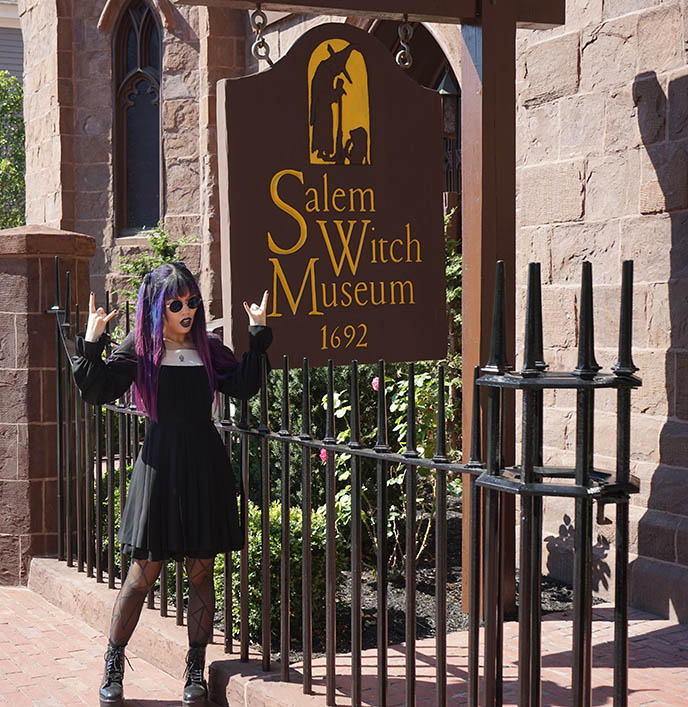
When I was in Salem MA, a child came up to me and yelled “Witchhh! Witchhh!” I took it as a compliment that she put me on trial (wearing Moi-meme-Moitie achieved the desired effect).
This September, I made a Goth pilgrimage to Salem, Massachusetts — the center of the 1692 century witch trials. As you’ll see, this little American town lives up to its notoriety as the ultimate Gothic destination.

The sign “Enter if you Dare” is apt. I have several friends who didn’t plan out their trip to Salem well, and ended up being disappointed (the shops and museums were closed, or they couldn’t get tickets or access to certain places).
Fear not — if you’re planning a trip to the witch capital, then this Goth travel blogger has got you covered. Here lies part 1 of my guide to getting the most out of a day trip to Salem MA, including how to plan transportation and see all the darkest, witchiest attractions.
† How to maximize Salem, in a nutshell †
– Come between spring-fall, but avoid the October tourist rush.
– Weekdays are less crowded, but make sure the places you want to see are open.
– Arrive around 10am, when the museums and shops open.
– Go to the Witch Museum first, as ticket slots sell quickly. Then make your rounds of other attractions and stores before things close around 5-6pm.
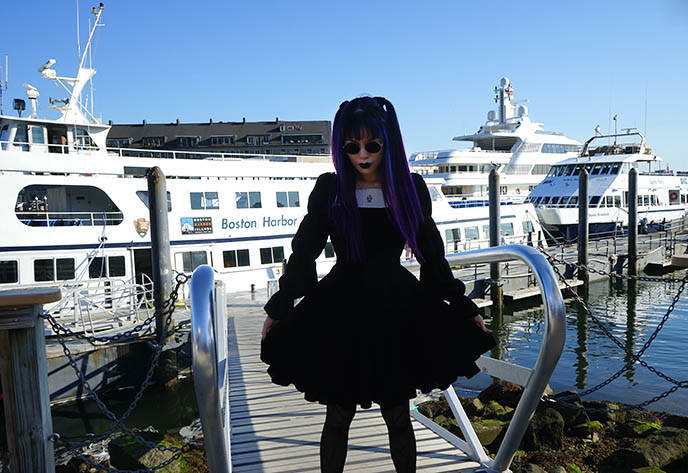
Let’s start with how to get to Salem. Unless you’re able to fly on a broom, most travellers come over from Boston — as this is the closest major city and airport.
Year-round, you can take the subway from Boston to Salem. Board the MBTA Commuter Rail (Rockport/Ipswich Line) from Boston’s North Station. In 30 minutes, you’ll be in Salem.
Boston Harbor Cruises also runs a Salem Ferry between mid-May and October 31. The boat sails from 1 Long Wharf, and the journey takes less than an hour.
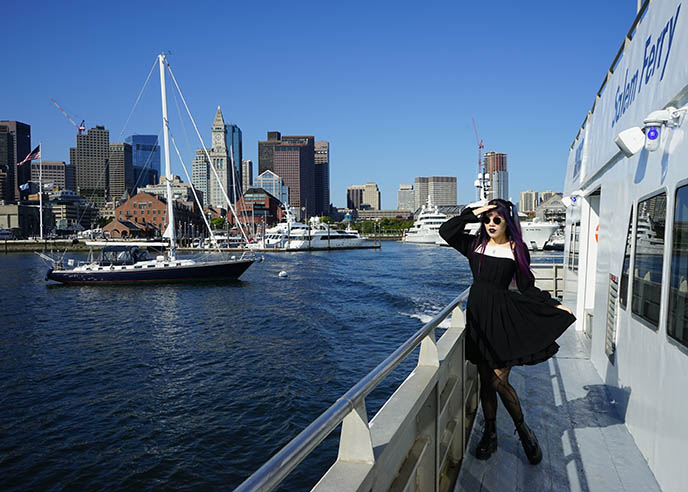
My friend Lissette and I took the earliest Salem Ferry sailing. We enjoyed being out on the water, and taking in Boston’s famous waterfront and brick skyline from the deck.
Be sure to reserve Salem Ferry tickets in advance from their website, as time slots can sell out. Also keep in mind that the boat route only runs from spring-fall.
(We took the subway back, as we wanted to stay past the last ferry departure; take note that the last train departs around 11:30pm. You can make Salem a day trip like we did, or book a room overnight if you want to take your time and see more.)
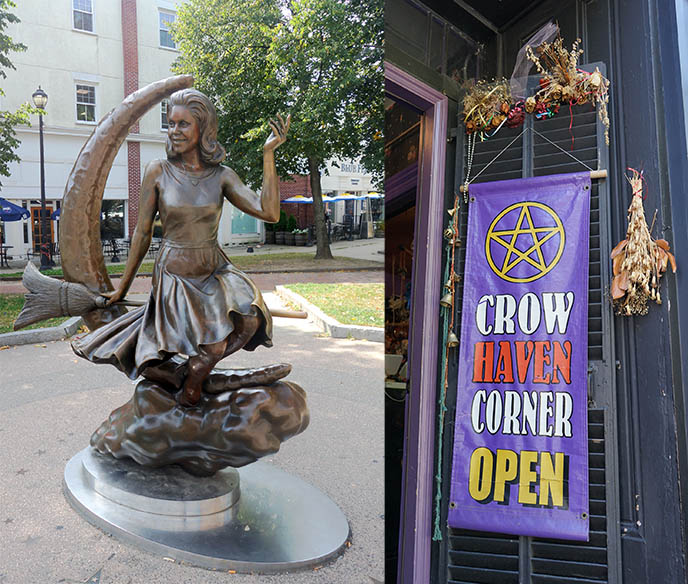
The moment you arrive in Salem, you’ll feel as if you have arrived in witch heaven! The quaint New England town is filled with occult symbols and spooky stores, much like in the movie Hocus Pocus (which was filmed here).
I walked by a statue of Samantha, the witch from the 1960s TV show Bewitched, by Lappin Park. The popular series shot a few episodes in Salem, which got people intrigued about traveling here. (Photo by my friend Julie.)

From the 1960s onward, Salem has embraced its witch / Halloween reputation to the fullest. Today, travellers flock here to learn about the late 17th century witch trials, and take part in all things Gothic (as the posters around town hint).
Thankfully, Salem remains a small town with a historic, indie and subculture feel — it hasn’t turned into a “Disneyland for Witches.”
That being said, Salem gets extremely busy around Halloween. Tourists are blocked from the graveyard in October, and you may encounter long lineups everywhere. I recommend coming in late September (like I did): you’ll still get to experience the fall / Halloween feeling, without too many people around.
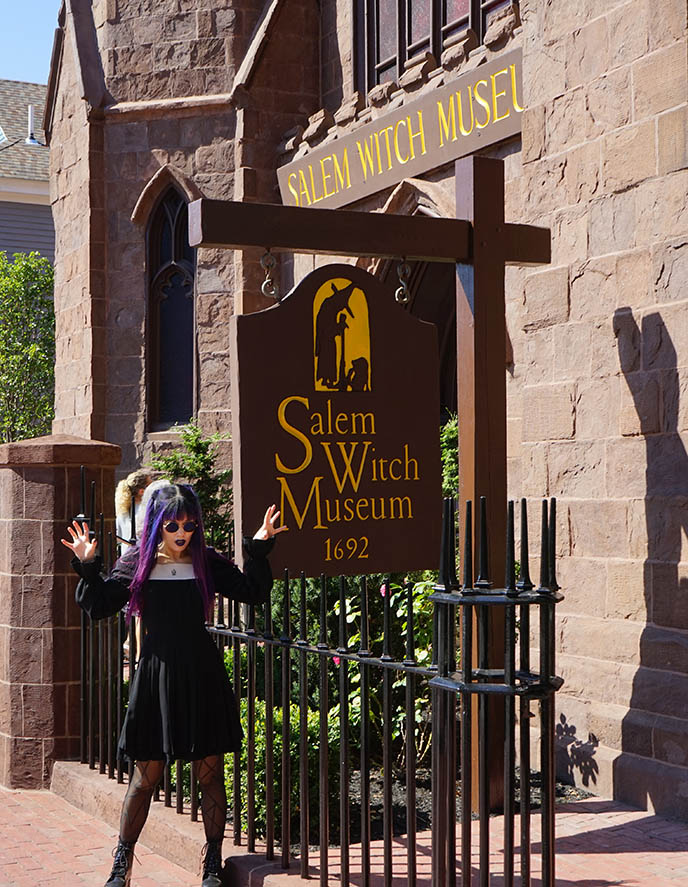
I’ve been waiting for this moment… Hail, Salem Witch Museum! This is the most popular museum in Salem, centering on the Witch Trials of 1692.
I did a “Puritan meets Harajuku Goth” look for this journey. The dress is a Moi-meme-Moitie rare Pleats from the early-mid 2000s; got it in Tokyo Japan, of course. I paired it with UK Tights, Edwardson Eyewear sunglasses, and Jeffrey Campbell platform ankle boots.
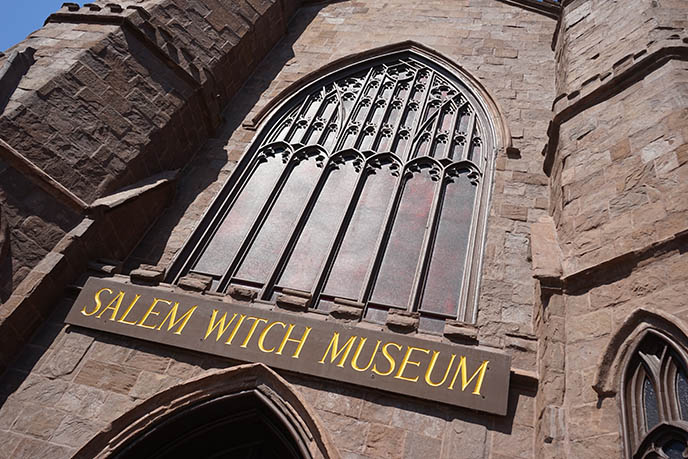
Goth alert: Get to the Salem Witch Museum early, ideally around opening time (10am). The tickets are first come first serve, and can’t be booked in advance. Since the passes are sold by 30-minute time slots, you might have to wait until a later hour to get inside. (We arrived around 11am and were lucky, as we got the next immediate entry).

If you need to kill time before the doors open, go next door to Salem Witch Museum’s gift shop. There’s an enormous selection of witch-themed books, jewelry, homewares and other memorabilia.
(My next article will focus on all the Gothic boutiques you must visit, so stay tuned for a full Salem shopping guide.)
My Alex Streeter Ouroboros ring fits in with the shop’s selection of witch brooms and magic spells.
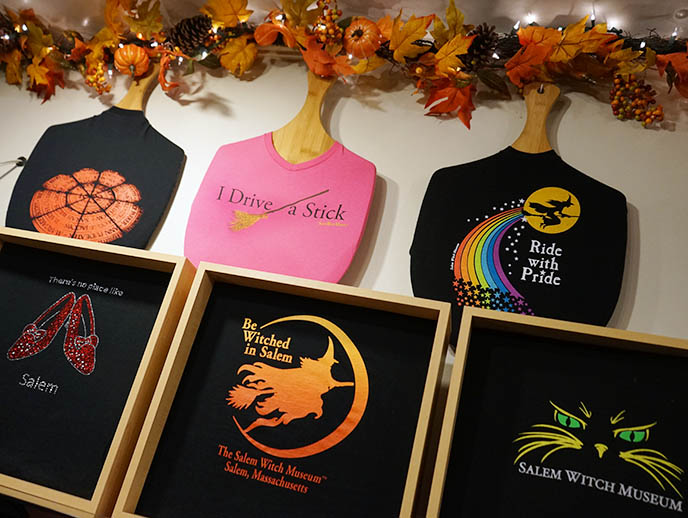
I was tickled to see a “Ride with Pride” t-shirt with a rainbow broomstick trail. As you’d expect, we ran into many fellow Goth and alternative travellers in this dark destination.

Our group was ushered inside, and the riveting presentation began. All around the room, life-sized sets lit up, and a narrator told the story of the 1692 Salem Witchcraft Trials in dramatic voices.
Photos aren’t allowed, so imagine… Satan, with red horns and glowing eyes! Did the “evil hand of the Devil” cause the “embittered women” to accuse hundreds of witchcraft, resulting in 30 courtroom death sentences?
I learned how a slave’s fortune-telling games led to weird behaviors and hysteria among a group of young women. Between 1692-3, hundreds (mainly outsiders such as older single women) were accused of “entering a pact with Satan.” By the end of the Salem witch trials, 20 were executed as witches, mostly by hanging.
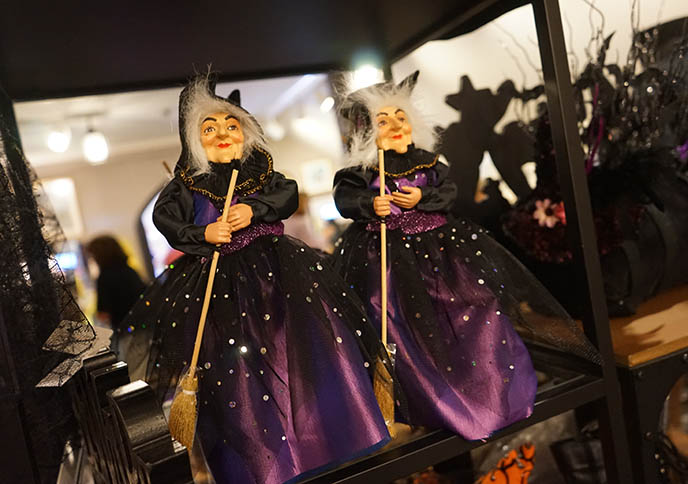
After, a guide took us to an exhibit on the evolving perspective of witches over the years: from pagan healing women, to green-faced crones on broomsticks (influenced by the Wizard of Oz).
The Salem Witch Museum was both entertaining and enlightening — I was fascinated by the tales of witch hunts throughout the ages. I was also glad I went here first, to learn about the town’s terrifying history before sightseeing further.
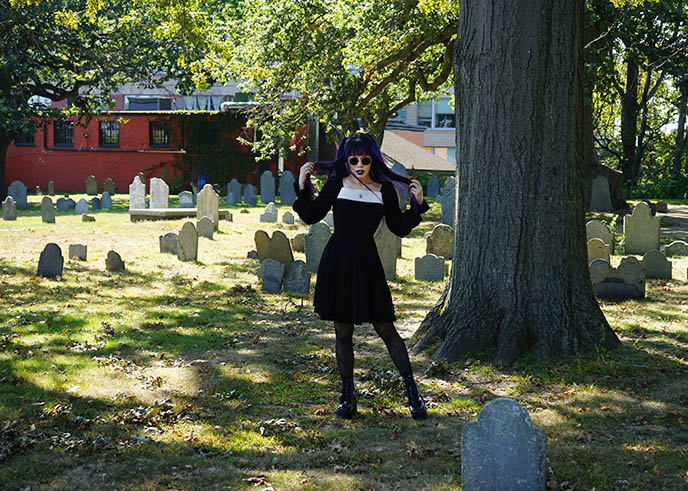
Since I was in a morbid mood, it made sense to stand among the tombstones of The Old Burying Point Cemetery. Also known as Charter Street Cemetery, this is one of the oldest graveyards in America (established 1637).
It’s right by the Salem Witch Trials Memorial: a simple granite monument with an open book etched with court transcripts, and benches carved with the victim’s names.
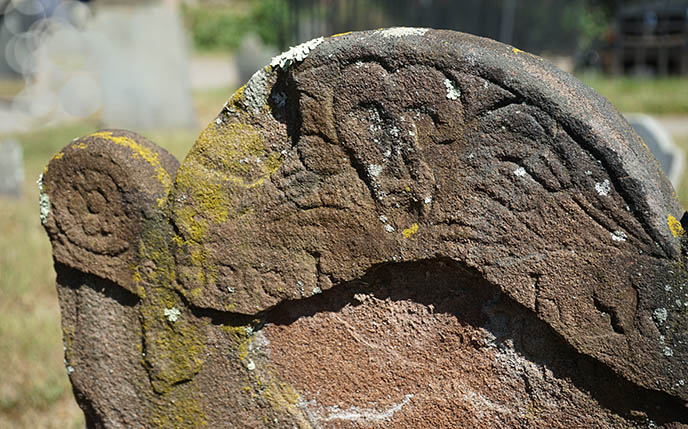
Many of the 17th century headstones were decorated with winged skulls — how pirate-Goth. Known as death’s heads or Soul Effigies, these represent the spirit flying to the afterlife.
(I have many more photos of these Gothic-looking Puritan tombstones in my article about Boston’s Granary Burying Grounds.)
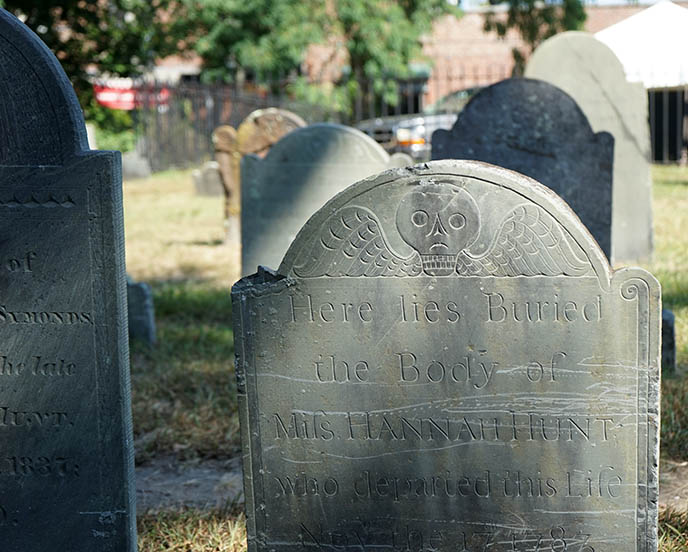
This year, Salem’s historic burial place was closed to visitors between late Sept and early Nov. October is peak season for Salem tourism, and they wanted to prevent damage to the centuries-old tombs. Keep the closure dates in mind, if you want to tread carefully among the dead.
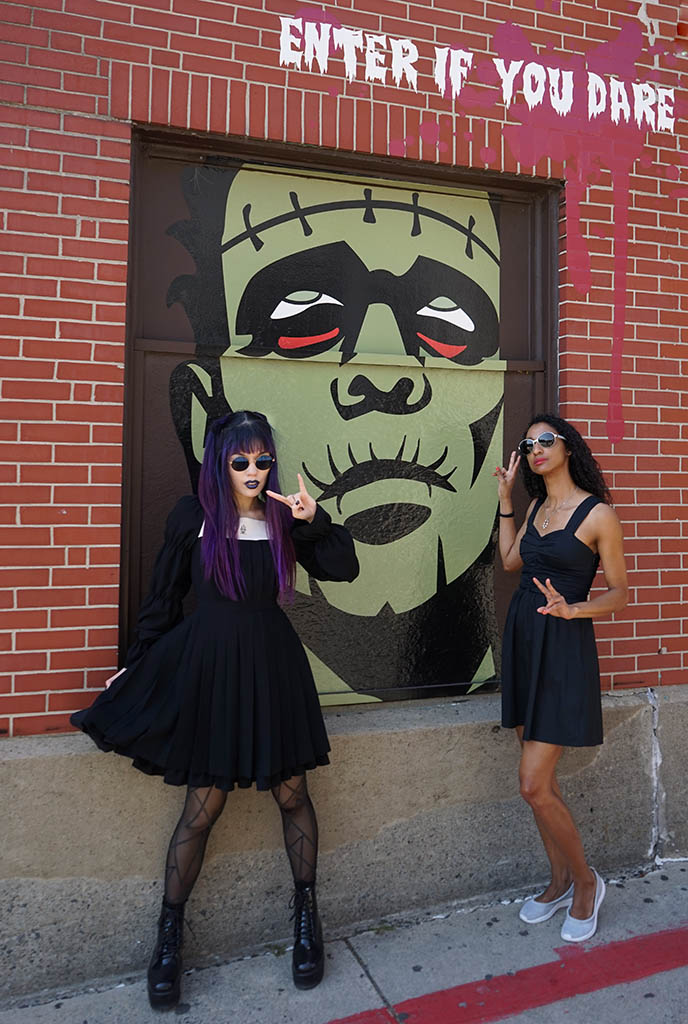
Lissette and I had until 5-6pm to see Salem’s other museums and boutiques.
I recommend browsing Destination Salem’s site, as they give a great run-down of all the restaurants, shows, tours, shops and attractions in Salem.
I personally wanted to focus on all things Goth and Witch, so I didn’t see some of the other highly-rated places, like the Peabody Essex art museum or House of Seven Gables (the mansion at the center of Nathaniel Hawthorne’s novel).

Some of Salem’s witch-related attractions seemed to be on the cheesy side, and I preferred to learn about the culture / history than to get scared at a haunted house (there are several here).
That’s why I stopped by the Salem Witch Village. A local man took us through a pathway of tableaus, which explored the legends, myths and truths about witches and their craft.

Rather than sensationalizing witches, the Village Museum taught us about the symbols and rituals of Wicca. Our guide talked about the many meanings of the pentacle (an upright five-pointed star in a circle). It’s a symbol of the elements and divine feminine, and a magical talisman that summons energies.
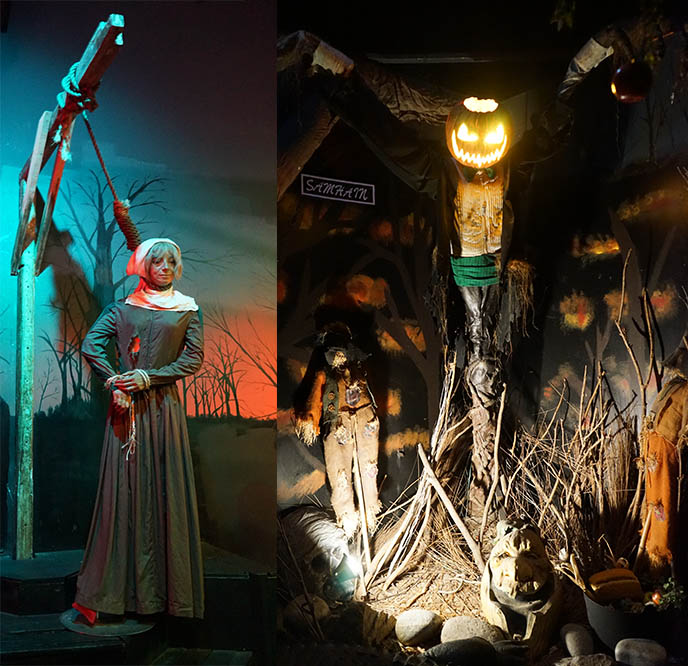
The tour delved deeper into the Salem Witch Trials. We saw a mannequin being pressed to death by giant rocks! This was Giles Corey, a man accused of being a warlock. Because he refused to plead guilty or not guilty, he was pressed over the course of three days. When asked what he wanted, Giles — his eyes bulging from the heavy boulders on his chest — defiantly told them to add “More weight!”
We also learned about the ancient pagan festival of Samhain, which takes place in October and influenced Halloween. I was thrilled by the tales of Jack O’ Lantern, a miserly man who tricked the Devil. Later, the horned one got his revenge and cursed Jack to roam the Earth until the apocalypse, with only an ember inside a turnip to light his way. (These carved turnips turned into Jack-o-lantern pumpkins lit by candlelight!)

Salem’s a small and walkable town, so Lissette and I were able to easily see multiple historic sites by foot in a single day.
I struck an ominous pose in front of The Witch House. Isn’t this dark and pointy-roofed home a Gothic dream? Built in the mid-17th century, this was the home of Judge Jonathan Corwin, who presided over the witch trials of 1692.

The Witch House is located at 310 Essex Street, and it’s a stunning example of New England architecture in the 17th century. I’ve been to many allegedly haunted houses, but in this case, the truth is scarier than sorcery. Swayed by witch-hunt hysteria, Judge Corwin’s court sent 20 wrongly-accused victims to the gallows, while others died in jail.

Inside, you can see relics of the diabolical trials. There were documents about witchcraft and demonic possessions, and examples of “witchcake.” This not-so-delicious cake was baked with the urine of possibly possessed girls, and fed to the household dog. Somehow, this could reveal whether the ladies were dabbling in black magic.

The upper levels gave me a peek of how limited life was for these Puritan women. The weaving wheel and wood cradle look like something out of a dark fairy tale…
Some theorize that the women “acted out” in response to their oppressive religious/patriarchal environment, leading to the witch-scares and executions.

The Witch House is open daily from mid-March through November. It’s great to go inside if you’re interested in the daily life and artifacts of the witch-hunting days. However, if you’re short on cash, you can just take photos outside.
(Side note: there’s a dark electronic music genre called witch house that emerged about a decade ago. Perhaps this could be my album cover.)
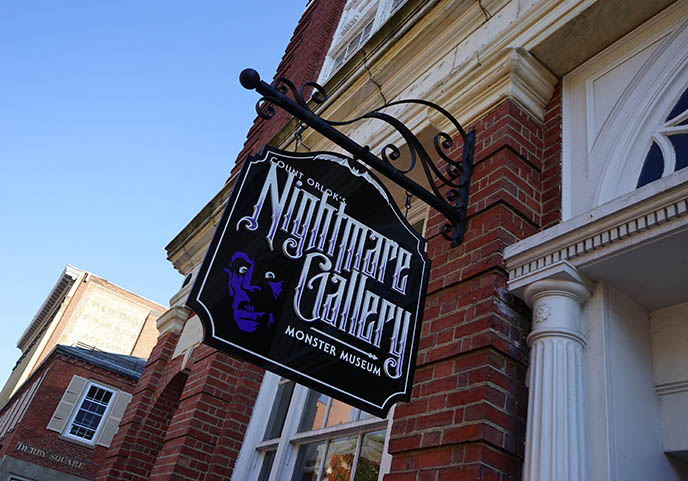
We wrapped up our museum escapades at Count Orlok’s Nightmare Gallery. Salem MA has a movie monsters permanent exhibition, and it’s a classic horror film buff’s dream (or nightmare).
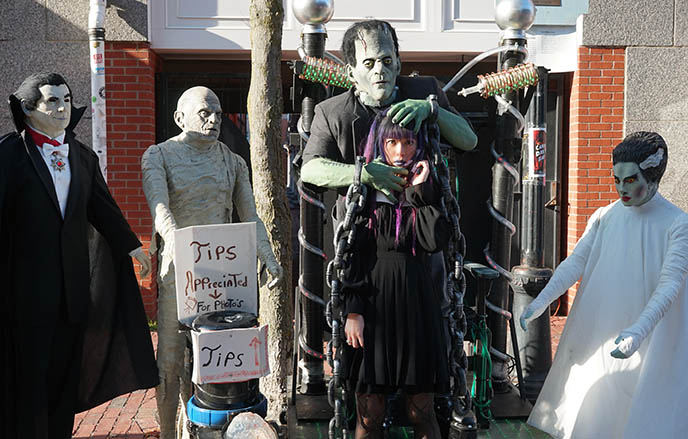
This town isn’t just about witches –– Salem has grown into a hotbed for all things horror and Halloween especially in October, when the annual Haunted Happenings take place.
Outside Count Orlok’s lair, I ran into these old-school monsters… and gave Frankenstein’s creature a tip in order to get strangled! (As my friend John S. would say, “I’d buy that for a dollar.”)
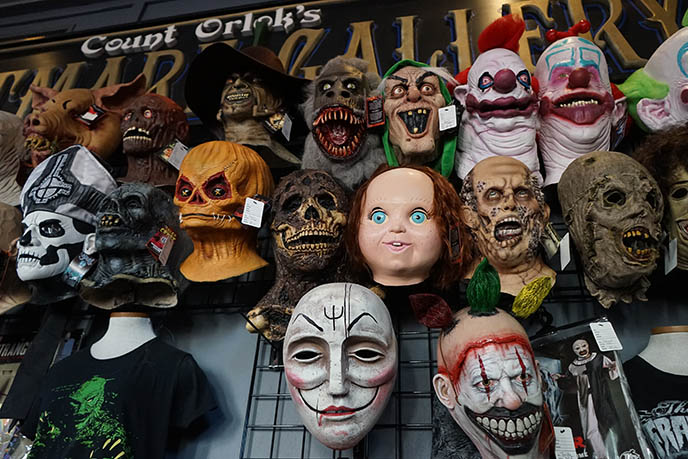
This private gallery is named after the Draculean baddie in the 1922 classic horror, Nosferatu. Photography isn’t allowed inside Count Orlok’s museum, so here are snaps from the gift store outside.

The admission fee is well worth it for the life-sized monsters and killers you’ll encounter inside. The Nightmare Gallery isn’t your typical cheesy wax museum. Made of resin, silicone and other life-like materials, these horror legends are impressively made and dramatically lit, with eerie music in the background of each room.
This mannequin insists, “Hi, I am NOT Slappy.” He’s been mistaken one too many times for Slappy the Dummy, from R. L. Stine’s Goosebumps books.
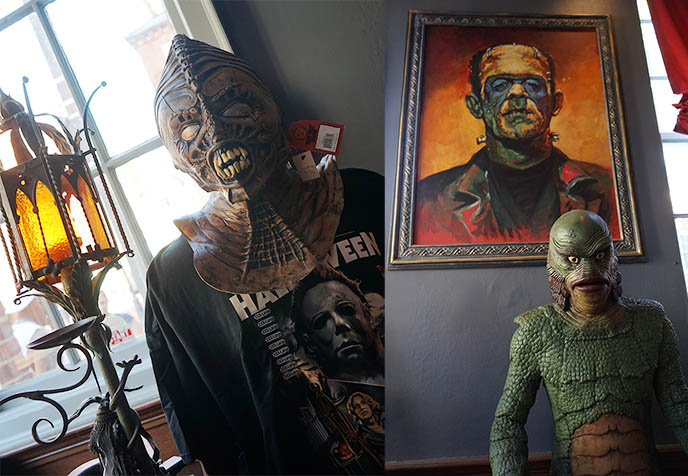
I appreciated the mix of old and new creatures inside Count Orlok’s. The tour begins with replicas of silent and black-and-white movie stars, dressed as their horror alter egos. Hello Boris Karloff as Frankenstein’s Monster, and Bela Lugosi as Dracula.
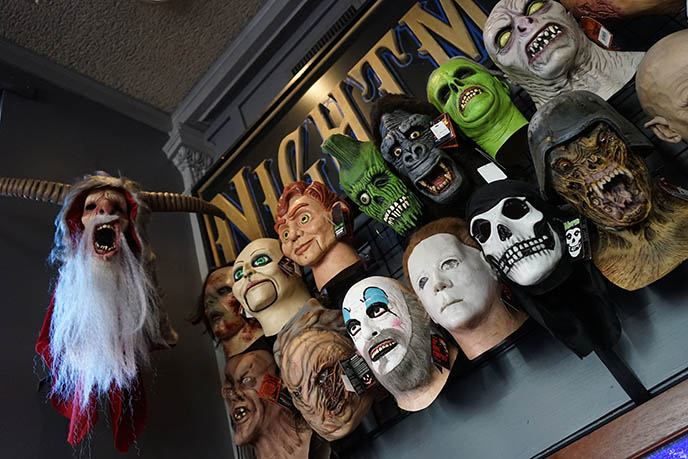
The human-sized creatures includes cult characters from The Shining, Halloween, Carrie, Friday the 13, Night of the Living Dead, and Trick ‘r Treat. (Can you recognize the masks above?)
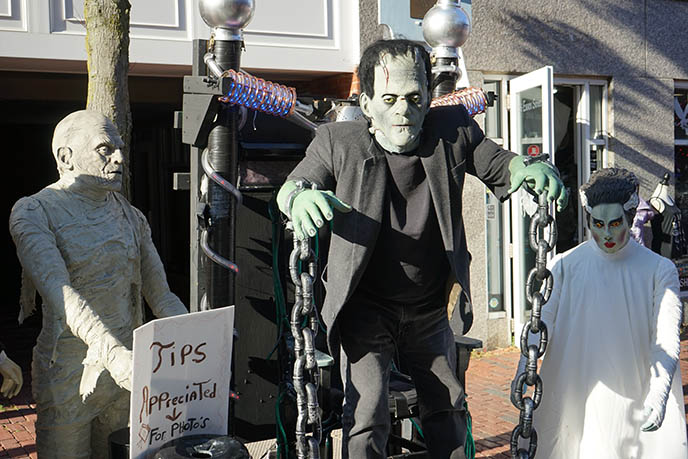
You’ll also see rare photos of the actors, and actual set pieces or props. I was wowed to see the real upside-down head with crab legs, from John Carpenter’s The Thing!
If the terrifying characters above stir your heart, then Count Orlok’s Nightmare Gallery is a must-see.
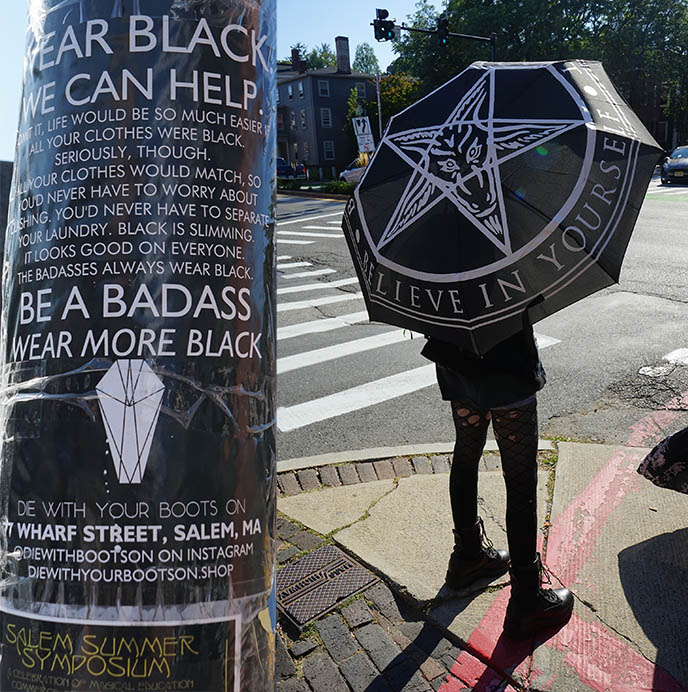
We packed so much into a single day-trip to Salem… this is only part 1 of my coverage! In the next piece, I’ll take you inside the most fabulous Goth, vampire and witch-themed indie boutiques. (As you’d guess, Salem is a Gothic shopping paradise, with stores like Die With Your Boots On.)
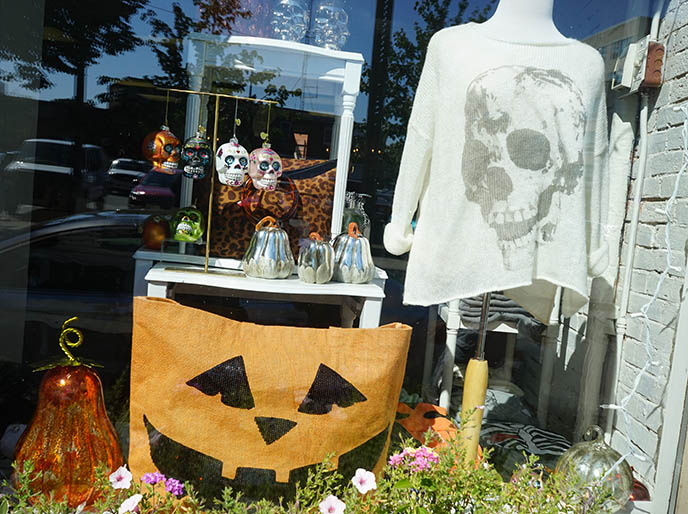
Now, let’s check out some spooky boutiques. Salem is an incredible destination for those who love Gothic fashion and home decor.
Some of the stores are more on the tourist side, and sell generic Halloween goods. However, there are also wonderful indie boutiques with local / handmade Goth items (like this skull sweater).

I didn’t get to go to every Goth store — I missed out on Die With Your Boots On, purveyor of underground / subculture fashion and locally made products.
Most of the Gothic boutiques are on Essex Street, between Summer – Washington – Hawthorne. I suggest starting at one end and walking along Essex, and meandering to the side streets as well.

Lissette and I were fans of Witch City Wicks, an independent, handmade, local candle and home goods company.
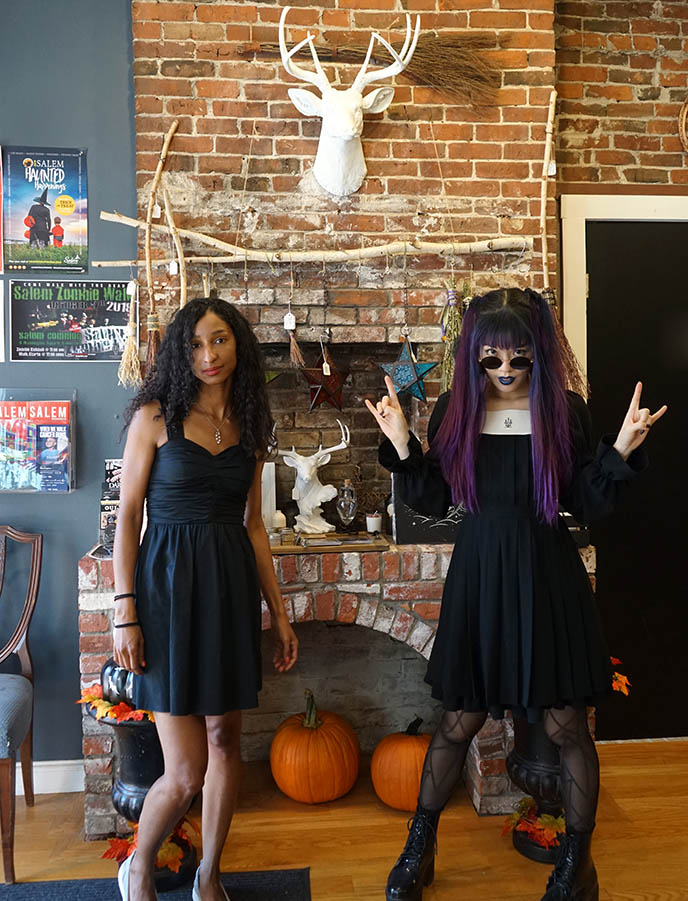
In addition to artisan candles, Witch City Wicks stocks hand-crafted interior decor and gifts — perfect for witchy women.

They carry an enticing selection of silver jewelry with witch and occult themes. These pentacle necklaces and pendants are by Burial Ground.

All their candles are made with vegan-friendly soy wax, and have alternative scents and packaging influenced by Salem’s culture.

Witches tend to be associated with horror and darkness in popular culture, but Witch City Wicks shows the positive, spiritual side of wicca.

Be ready to spend when you’re in Salem… it’s hard to resist designs like these, especially when they are by indie makers.

Bubble, bubble, toil and trouble… Can you picture me stirring a cauldron by this hearth?
I’m wearing a rare OG pleats dress by Moi-meme-Moitie (the elegant Gothic Lolita brand of Mana-sama, guitarist of Moi dix Mois and Malice Mizer).
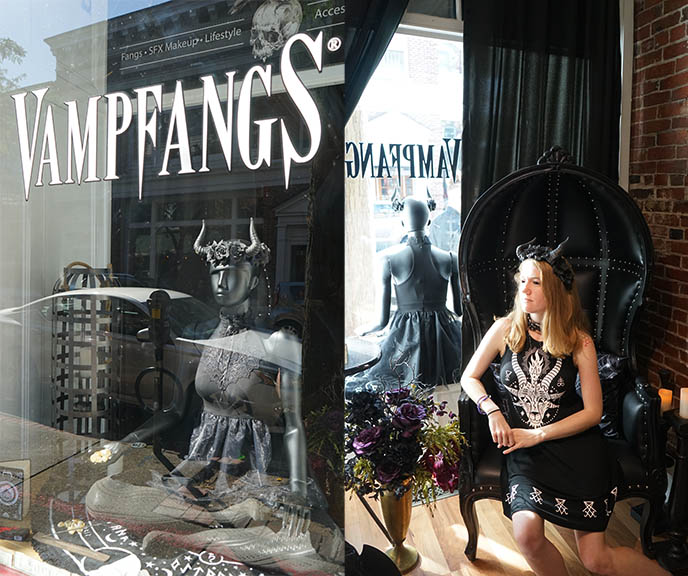
Salem isn’t just for witches. The little New England town with a ghastly history had drawn in other bloody subcultures.
Coffin-dwellers will love the boutique Vampfangs. Founded in 1993, they carry all things vampire-related including red contacts and sharp fangs.
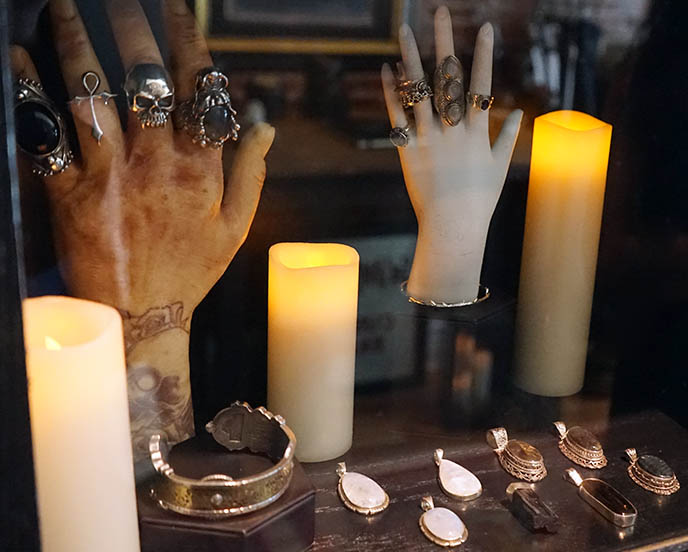
There’s a selection of jewelry that looks like it belongs to Lestat. I spot an anhk and skull.
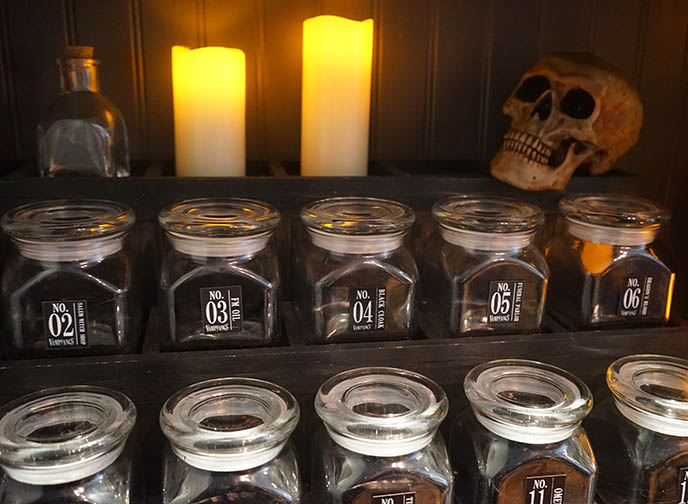
Vampfangs also has a variety of fragrances, oils and skincare — wiwth vampiric names like Bitten, Immortal, Funeral Parlor, Black Cloak.

Need a skull, or a horned headband? Vampfangs has you covered.
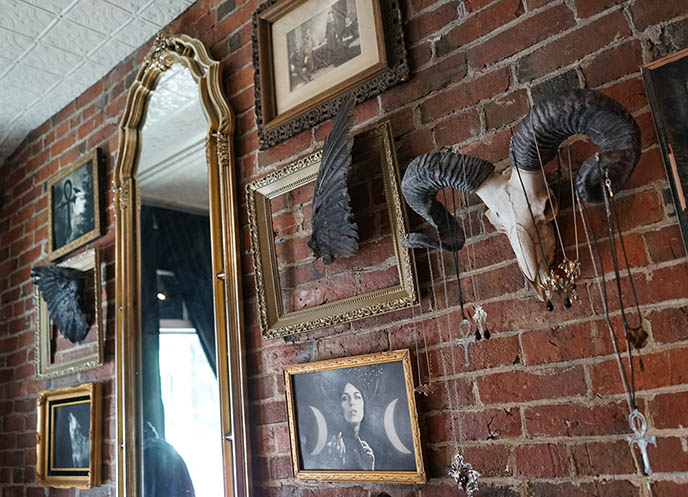
These specialty boutiques are run by locals who participate in the subculture, and put careful attention to design details. Salem’s historic atmosphere adds to the charm of shopping for Goth goods.
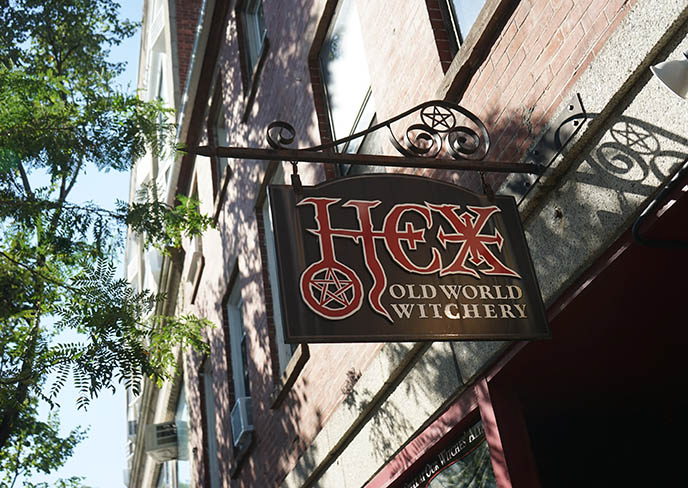
“I put a spell on you…” All your ritual needs can be found at Hex Old World Witchery.
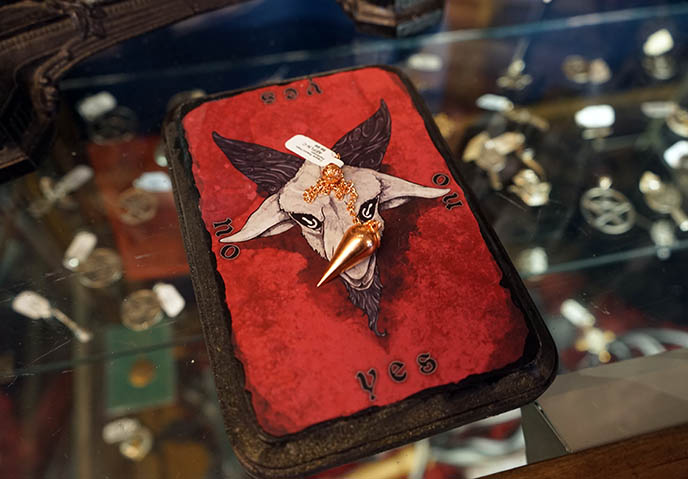
This old world witchcraft store is a wonderland of herbs, crystals, divination objects, voodoo dolls…

Hex pays homage to deities and demons from all cultures. The Satanic Baphomet sits next to Kali, Hindu goddess of destruction (remember I visited her temples in India?)
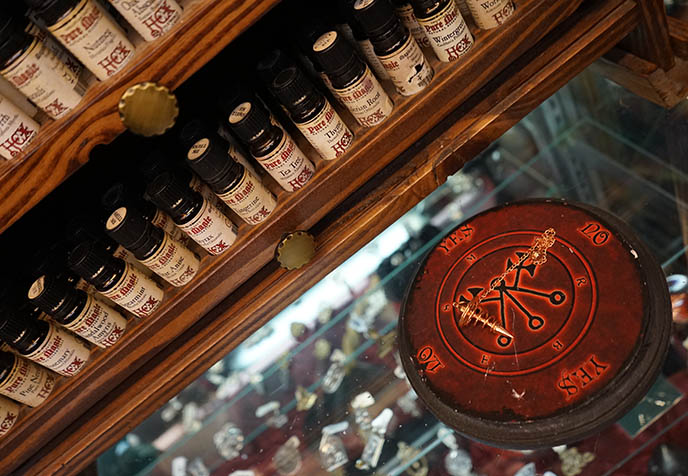
So many potions to choose from… In Salem, it’s always the Season of the Witch.
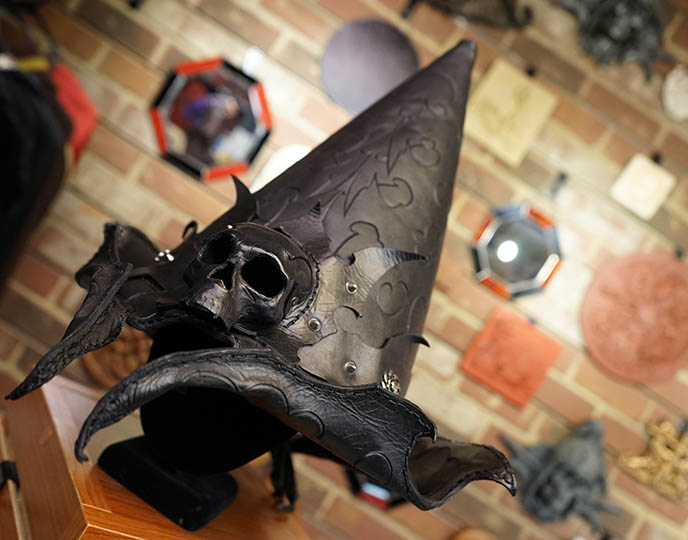
Can you picture yourself wearing this pointed witch hat with a skull?
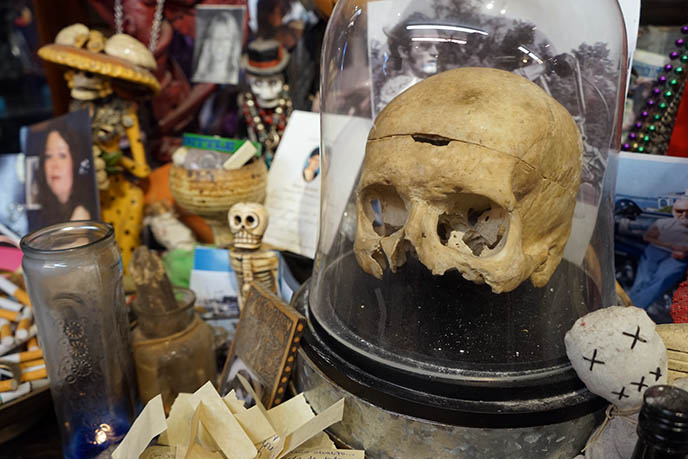
Be sure to pay your respects to the altar at the entrance of Hex, which brings together Santa Muerte candles, voodoo dolls and a human skull.

Many Salem stores run special events and workshops. No matter when you visit, you’ll find something witchy or artistic to partake in. Tarot card readings, spell casting, broom-making… If only I had more time!

You can visit the store websites and Destination Salem to learn about upcoming activities. Or just wander around, and see what happens to be going on (we stumbled upon a small vendors fair).

The sun, it burns! Outside The Coven’s Cottage, which has a pagan and metaphysical focus, especially on Norse/Asatru.

The word “witch” is found on pretty much everything in Salem… Impossible to see everything in a single day. I’ll have to come back for more.
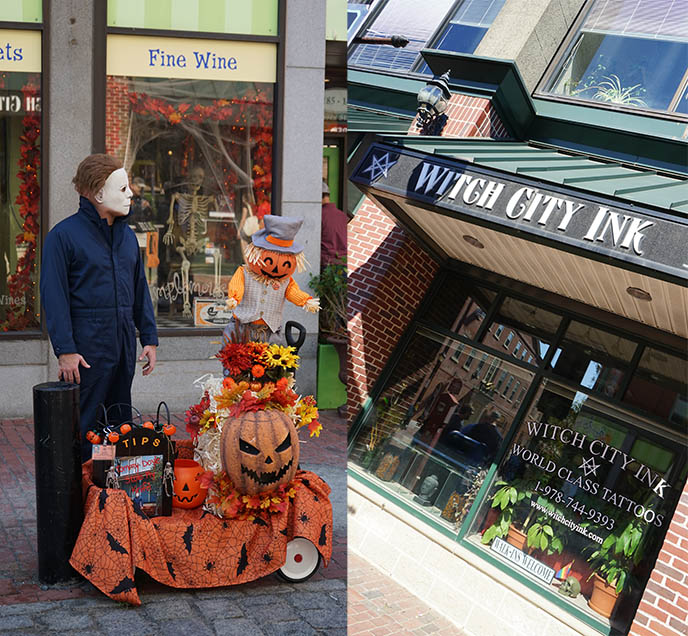
Be sure to read this post about my second visit as it covers additional spooky places like the Witch Board Ouija museum.

At any time of the year, you’ll find dark and monstrous events in Salem. I’ll gladly go back any time to experience more of this Goth destination.
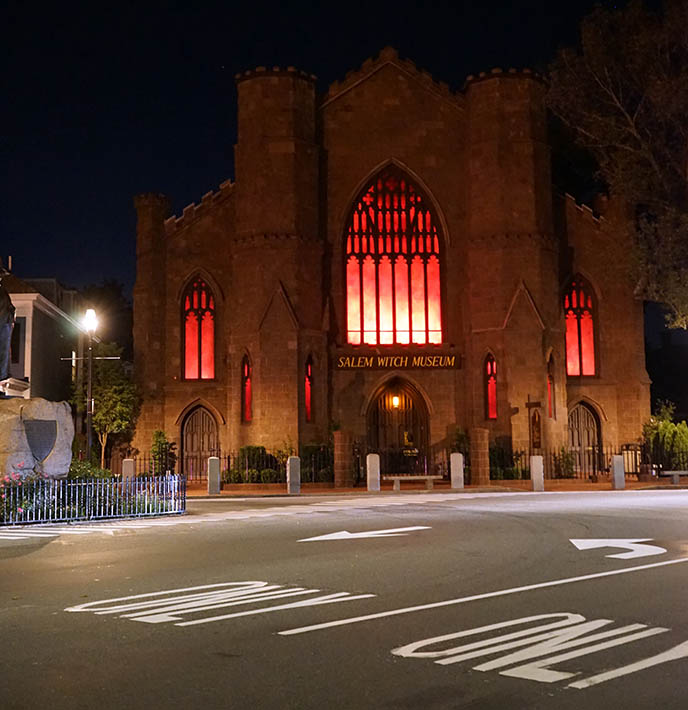
The last train from Salem to Boston departs around 11:30 pm, so if you’re staying late, keep an eye on the clock.
Salem is fun to walk around at night. Lots of lively cafes and bars, and the Salem Witch Museum glows red with the fires of hell.
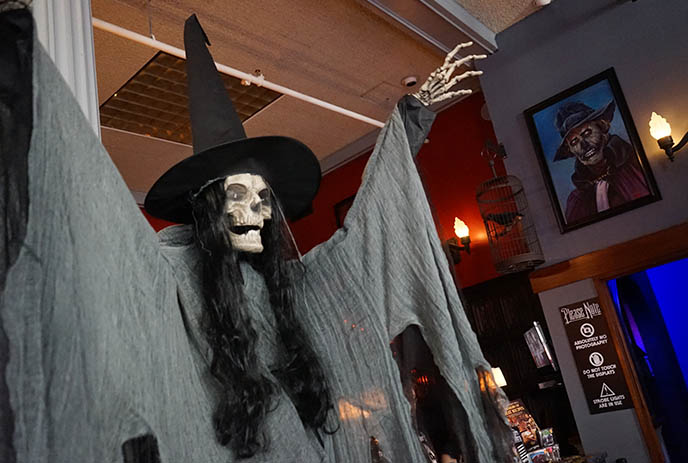
Hail Witches! Thanks to Destination Salem for supporting our trip here. Their website and visitor center (a short walk from the train station) are excellent resources for planning your journey.
PS, speaking of horror: my episode of The Purge TV show airs Dec 17 on USA Network and Amazon! Next, I’ll take you behind-the-scenes of my television shoot and set experience in New Orleans.
SHARE & COMMENT

 LA CARMINA
LA CARMINA






